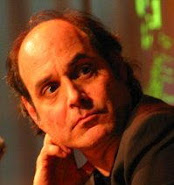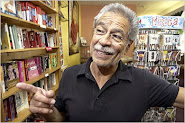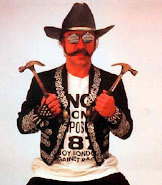 Lesson plan created by Jessica B. Muniz, MSW, Doctoral StudentProgram in Culture, Literacy, and LanguageDivision of Bicultural Bilingual StudiesUniversity of Texas, San Antonio
Lesson plan created by Jessica B. Muniz, MSW, Doctoral StudentProgram in Culture, Literacy, and LanguageDivision of Bicultural Bilingual StudiesUniversity of Texas, San Antonio Background Information
John Jesurun, a winner of the MacArthur "Genius" Fellowship in 1996, is widely acknowledged as one of the foremost innovators of avant-garde theater, creating virtuoso works that overlap media and language in surprising and unpredictable ways. Each episode of CHANG IN A VOID MOON plays with various media forms, pop-cultural constructs and entertainment genres. Essentially a soap opera, the drama (comedy and mystery) of "Chang…" revolves around the exploits of a businessman by that name and his schemes to defraud the Peters clan, a wealthy family steeped in severe dysfunction. The construction of "Chang…" is as important as its text. It is converged by the influence of film, television and radio rather than by theatrical convention. Scenes begin and end abruptly, as if cut and spliced together. Camera effects are replicated: actors are frequently suspended on platforms in various configurations to suggest overhead shots, long shots, and shots from below. Stagings have included helicopter rescues, sailboat races, a floating saxophone, car crashes and chases.
Like all of Jesurun’s work, Chang is driven by word-play: puns, allusions, and non-sequiturs. Playful phrasing enhances the dialogue’s rhythmic quality, and speaking Jesurun’s dialogue, his characters create a nearly symphonic chorus. Throughout the play, rhythms are often interrupted then redeveloped. This style, distinctly Jesurun’s, has been viewed as a precurser of “sampling” which anticipated the technique’s casual and widespread use in all forms of pop music. Music is by Barbez, a New York art-rock ensemble. The New Yorker has written, “Barbez includes a brilliant theremin player who smokes cigarettes and a full –throated Russian singer who comes across like Joan of Arc with a sense of Humor. They cover everything from Bertolt Brecht to Black Sabbath, but the real attractions is their melodically haunting originals. With a folk-music sound located somewhere between turn-of-century Eastern Europe and modern America, it’s arty rock that moves between brooding and winking.”
Born in Battle Creek, MI in 1951, John Jesurun was originally trained as a sculptor at the Philadelphia College of Art and studied film at Yale before turning to playwriting in the early 1980's. He was the Associate Producer of "The Dick Cavett Show." for two years. He has received grants and fellowships from the Rockefeller and Guggenheim Foundations as well as the NEA. In addition to La MaMa, his works have been presented in major venues and festivals both nationally and internationally. Jesurun's work has long been distinguished by his use of film and video to destabilize the audience's sense of reality. In 1986, his "Deep Sleep" had two 70-minute films projected on facing screens while the five actors were caught in between. The on-screen actors warned their live equivalents, "Do you see the machines? They're the projectors. They are projecting you...You must get off that roll of film so that when the film runs out you'll be safe."
With "Chang…," Jesurun has consistently worked with some of New York’s most exciting performers. Over the years his company has featured: Steve Buscemi, Ethyl Eichelberger, the performance artist John Kelly, Black-Eyed Susan. George Osterman, David Cale, Michael Tighe, Rebecca Moore, Frank Maya, Mimi Goese, and choreographer Neil Greenberg, among others. Many of these performers first came to prominence with their work in "Chang…," and most of them continue to appear in new episodes. Jesurun received an Obie in 1986 for "Deep Sleep." His other La MaMa works to-date are "Black Maria" (1987), "Red House" (1984), "Number Minus One" (1984), "Dog's Eye View" (1984), "Iron Lung" (1992), "Point of Debarkation" (1993), “Slight Return” (1995) and a revival of his most famous work, "Shatterhand Massacree," in 1992. His play "Philoktetes," written for Ron Vawter, has been published in the Yale Theater Magazine. It will be presented by The Club at La MaMa this Spring, from March 4 to 21, 2004. Jesurun's "Faust/How I Rose" will be presented at BAM's Next Wave Festival in Fall, 2004.
Lesson Plan Title
Finding out about A Genius
Pre-Instruction or Prerequisite Knowledge/Skills
Basic critical analysis, writing, and theatrical skills
Lesson Duration
Lesson Duration
4-5 sessions, 1-2 hours each
Students may choose to do research outside of class.
Learning Location
Learning Location
Computer lab and/or classroom, open space to rehearse
Materials
Materials
Computers with printer/paper, chart paper
Learning Objectives (Teacher may wish to modify them as she/he deems necessary)
Grades 6-8
English Language Arts/Reading
TEKS 2A: The student is expected to interpret speakers' messages (both verbal and nonverbal), purposes, and perspectives.
15F: The student is expected to compare text events with his/her own and other readers’ experiences.
18A: The student is expected to choose the appropriate form for his/her own purpose for writing.
14A: The student is expected to generate ideas and plans for writing.
Fine Arts
TEK 4A: The student is expected to demonstrate in dramatic activities that theatre is areflection of life.
Grades 9-12
English Language Arts/Reading
TEKS 20A, B: The student is expected to investigate the source of a media presentation or production such as who made it and why it was made; deconstruct media to get the main idea of the message's content.
1A: The student is expected to write in a variety of forms with an emphasis on literary forms such as fiction, poetry, drama, and media scripts
9B: The student is expected to compare text events with his/her own and other readers' experiences.
Fine Arts
TEKS 2A, C: The student is expected to demonstrate safe use of the voice and body; portray believable characters when applying acting concepts, skills, and techniques.
Tasks
1.) Teacher will ask: Who is a genius? Students will develop a definition of "genius" to include concepts of ethnicity.
2.) Teacher will write students’ definitions on chart and discuss different concepts of the definition of "genius"
3.) Teacher will use Internet site to discuss the MacArthur Foundation and Fellows (geniuses). www.macfound.org/programs/fel/fel_overview.htm
4.) Teacher will inform students that John Jesurun is a MacArthur genius.
5.) Students will conduct an internet search on John Jesurun to create a timeline on his works.
6.) Students create a poster/powerpoint presentation utilizing the 5Ws and How to display in their classroom on John Jesurun. http://en.wikipedia.org/wiki/Five_Ws
7.) Students will work in groups of 4-5 students to choose area of interest based on John
Jesurun's theatre works or art, to write a play which they will perform in their classroom.
8.) Teacher will review the components of a play http://www.ehow.com/how_2045040_write-play.html
9.) Students will use their lived experiences and search engines to find information about their area chosen.
10.) Students will work with their group to write the play.
11.) Each group will distribute a final copy of their play to the teacher for review.
12.) Students will perform their play to their classmates.
13.) Students will evaluate the group process and the final work of art based on evaluation components decided by teacher.
14.) Teacher will conclude the lessons by engaging students in conversation about defining "genius" and what has changed in the student's mind about what "genius" means.






No comments:
Post a Comment